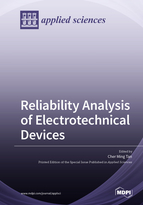Reliability Analysis of Electrotechnical Devices
A special issue of Applied Sciences (ISSN 2076-3417). This special issue belongs to the section "Mechanical Engineering".
Deadline for manuscript submissions: closed (20 March 2022) | Viewed by 29341
Special Issue Editor
Interests: reliability modeling; reliability statistics; failure analysis; prognosis and health management; reliability simulation
Special Issues, Collections and Topics in MDPI journals
Special Issue Information
Dear Colleagues,
The smart world involves complex electrotechnical systems and devices, which have improved our lives significantly. Consequently, we are heavily dependent on them, and their reliability has become crucial. However, ensuring the reliability of complex systems and devices can be challenging, especially in a cost-effective manner. This Special Issue focusses on various methods and examples to improve, evaluate, and predict the reliability of electrotechnical systems and devices that constitute smart systems and the smart world.
Topics of interest to be covered by the Special Issue include but are not limited to reliability and its related topics of the following electrotechnical systems and devices :
- Electron devices;
- Electro-optical devices;
- Batteries and packs;
- MEMS and NEMS;
- Vacuum devices;
- Renewable energy devices and systems;
- Bio-medical electronic devices;
- Wearable devices and systems;
- Automotive electronic devices;
- Electrical energy system;
- Engineering system maintenance;
- Nano-electronic devices and systems.
Prof. Dr. Cher Ming Tan
Guest Editor
Manuscript Submission Information
Manuscripts should be submitted online at www.mdpi.com by registering and logging in to this website. Once you are registered, click here to go to the submission form. Manuscripts can be submitted until the deadline. All submissions that pass pre-check are peer-reviewed. Accepted papers will be published continuously in the journal (as soon as accepted) and will be listed together on the special issue website. Research articles, review articles as well as short communications are invited. For planned papers, a title and short abstract (about 100 words) can be sent to the Editorial Office for announcement on this website.
Submitted manuscripts should not have been published previously, nor be under consideration for publication elsewhere (except conference proceedings papers). All manuscripts are thoroughly refereed through a single-blind peer-review process. A guide for authors and other relevant information for submission of manuscripts is available on the Instructions for Authors page. Applied Sciences is an international peer-reviewed open access semimonthly journal published by MDPI.
Please visit the Instructions for Authors page before submitting a manuscript. The Article Processing Charge (APC) for publication in this open access journal is 2400 CHF (Swiss Francs). Submitted papers should be well formatted and use good English. Authors may use MDPI's English editing service prior to publication or during author revisions.
Keywords
- Reliability
- Durability
- Maintenance
- Availability
- Risk
- Safety
- Electron devices
- Electro-optical devices
- Batteries and packs
- MEMS and NEMS
- Vacuum devices
- Renewable energy devices and systems
- Bio-medical electronic devices
- Wearable devices and systems
- Automotive electronic devices
- Electrical energy system
- Engineering system maintenance
- Nano-electronic devices and systems






